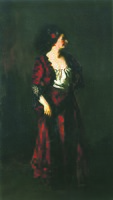
Robert Henri
Robert Henri (/ˈhɛnraɪ/; June 24, 1865 – July 12, 1929) was an American painter and teacher.
Not to be confused with Henri Robert.
Robert Henri
July 12, 1929 (aged 64)
Painting
As a young man, he studied in Paris, where he identified strongly with the Impressionists, and determined to lead an even more dramatic revolt against American academic art, as reflected by the conservative National Academy of Design. Together with a small team of enthusiastic followers, he pioneered the Ashcan School of American realism, depicting urban life in an uncompromisingly brutalist style. By the time of the Armory Show, America's first large-scale introduction to European Modernism (1913), Henri was mindful that his own representational technique was being made to look dated by new movements such as Cubism, though he was still ready to champion avant-garde painters such as Henri Matisse and Max Weber.
Henri was named as one of the top three living American artists by the Arts Council of New York.
Early life[edit]
Robert Henri was born Robert Henry Cozad in Cincinnati, Ohio, to Theresa Gatewood Cozad and John Jackson Cozad, a gambler and real estate developer.[1][2] Henri was a distant cousin of the painter Mary Cassatt.[3] In 1871, Henri's father founded the town of Cozaddale, Ohio. In 1873, the family moved west to Nebraska, where John J. Cozad founded the town of Cozad.[3][4]
In October 1882, Henri's father became embroiled in a dispute with a rancher, Alfred Pearson, over the right to pasture cattle on land claimed by the family. When the dispute turned physical, Cozad shot Pearson fatally with a pistol. Cozad was eventually cleared of wrongdoing, but the mood of the town turned against him. He fled to Denver, Colorado, and the rest of the family followed shortly afterwards. In order to disassociate themselves from the scandal, family members changed their names. The father became known as Richard Henry Lee, and his sons posed as adopted children under the names Frank Southern and Robert Earl Henri (pronounced "hen rye"). In 1883, the family moved to New York City, then to Atlantic City, New Jersey, where the young artist completed his first paintings.[5]
Education[edit]
In 1886, Henri enrolled at the Pennsylvania Academy of the Fine Arts in Philadelphia, where he studied under Thomas Anshutz, a protege of Thomas Eakins, and Thomas Hovenden, who was especially interested in anatomy.[6][7] In 1888, he traveled to Paris to study at the Académie Julian,[8] where he studied under the academic realist William-Adolphe Bouguereau, came to admire greatly the work of Francois Millet, and embraced Impressionism. "His European study had helped Henri develop rather catholic tastes in art."[9] He was admitted into the École des Beaux Arts. He visited Brittany and Italy during this period. At the end of 1891, he returned to Philadelphia, studying under Robert Vonnoh at the Pennsylvania Academy. In 1892, he began teaching at the Philadelphia School of Design for Women. "A born teacher, Henri enjoyed immediate success at the school."[10]
Influence and legacy[edit]
From 1915 to 1927, Henri was a popular and influential teacher at the Art Students League of New York. "He gave his students, not a style (though some imitated him), but an attitude, an approach, [to art]."[31] He also lectured frequently about the theories of Hardesty Maratta, Denham Waldo Ross, and Jay Hambidge.[32] (Henri's interest in these men, whose ideas were in fashion at the time but were not taken seriously later, has proved to be "the most misunderstood aspect of [Henri's] pedagogy").[33] Maratta and Ross were color theorists (Maratta manufactured his own system of synthetic pigments), while Hambidge was the author of an elaborate treatise, Dynamic Symmetry, that argued for a scientific basis for composition. Henri's philosophical and practical musings were collected by former pupil Margery Ryerson and published as The Art Spirit (1923), a book that remained in print for several decades. Henri's other students include George Bellows, Arnold Franz Brasz, Stuart Davis, Edward Hopper, Rockwell Kent, Henry Ives Cobb, Jr., Lillian Cotton, Amy Londoner, John Sloan, Minerva Teichert,[34][35] Peppino Mangravite, Rufus J. Dryer, Yasuo Kuniyoshi, and Mabel Killam Day.
The significance and often formative influence of Henri as a teacher and mentor is estimable. He also was instrumental in promoting women to be artists.[36]
In the spring of 1929, Henri was named as one of the top three living American artists by the Arts Council of New York. Henri died of cancer that summer at the age of sixty-four. He was eulogized by colleagues and former students and was honored with a memorial exhibition of seventy-eight paintings at the Metropolitan Museum of Art. Forbes Watson, editor of The Arts magazine wrote, "Henri, quite aside from his extraordinary personal charm, was an epoch-making man in the development of American art."[37]
Fittingly, among Henri's most enduring works are his portraits of his fellow painters. His 1904 full-length portrait of George Luks (in the collection of the National Gallery of Canada in Ottawa)[38] and his 1904 portrait of John Sloan (in the collection of the National Gallery of Art in Washington, DC, formerly in the collection of The Corcoran Gallery of Art in Washington, D.C.),[39] for example, exhibit all the classic elements of his style: forceful brushwork, intense (if dark) color effects, evocation of personality (his and the sitter's), and generosity of spirit.














